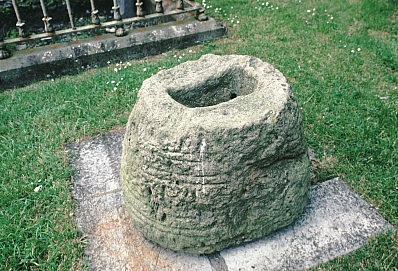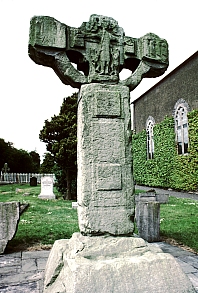

| Other High Crosses on this site include: the Muiredach Cross at Monasterboice (many details), the west and north cross at Monasterboice, the South Cross and the Ruined Cross at Kells, and two high crosses at Kilfenora. Freestanding, monumental crosses (sometimes up to 17 feet high) are associated with many of the early medieval monasteries of Ireland. Remnants of more than 200 of these so-called high crosses remain, often with several at the same site, although repetition of design was apparently avoided. Although they are found elsewhere in the Great Britain, the style is characteristically Irish. Some are relatively plain; others are decorated with abstract ornament (Celtic interlace and spirals, geometric patterns, inhabited vines, and entangled figures). The most sophisticated have panels with figural sculpture on Christian themes. These, however, do not "illustrate" the Bible; rather, the stories were chosen for their symbolic meaning (especially the Crucifxion and Christ's Passion) or their typological significance (stories from the Old Testatment which foreshadowed events associated with Christ). The iconographic sources include early Christian art (especially maunuscript illumination), Coptic Egyptian art (textiles), and animal motifs from the Near East and Migration period art and artifacts. Most of the crosses were made of various types of sandstone, which is somewhat easy to carve. Today many are in an eroded state with details barely discernible. | |
 |
Typical formThese high crosses often consisted of separate pieces of stone--a massive block serving as the base, a shaft and ringed cross head which fit into the socket at the base, and a cap (sometimes a miniature house with a gabled roof) from a smaller piece of stone. Some taller crosses used an additional joint just below the ring. The mortice and tenon system, reminiscent of carpentry, was used to join the separate pieces. The ring is a distinctive feature--or the circle intersected cross, and within the arcs are sometimes small rolls. Some art historians believe the rings were introduced as a method of support for the cross arms since the lower sections can provide reinforcement. Others point out that the circle, or wreath, was a symbol of triumph, used in the 4th-5th century in Roman and Early Christian art. The ring would have been difficult to carve; sometimes the ring was left as a solid block. This famous high cross, the so-called Muiredach Cross, is at Monasterboice, County Louth, Ireland. |
 |
A heavy base with socket for the tenon of the shaftThe heavy bases of the Irish crosses may allude to the rock of Golgotha, especially since often (see above) they are larger than necessary for support. |
 |
An unfinished cross at Kells (County Meath)This cross gives some idea of the working methods in carving the high crosses. The areas intended for small figural sculpture have been blocked out in the projecting panels. The carving for the crucifixion is almost finished. The interlace patterns on the cross ring are finished, even before the rest of the cross was started. |
 Click here to return to places index.
Click here to return to places index.
 Click here to return to index of artists and architects.
Click here to return to index of artists and architects.
 Click here to return to chronological index.
Click here to return to chronological index.
